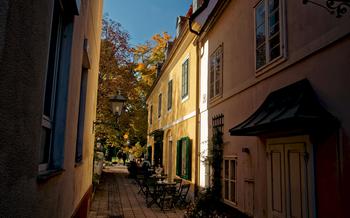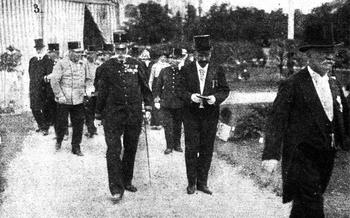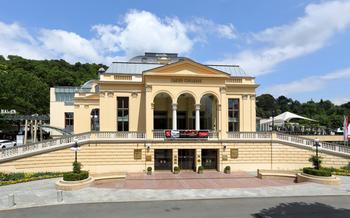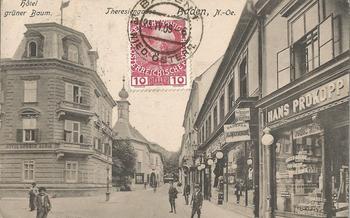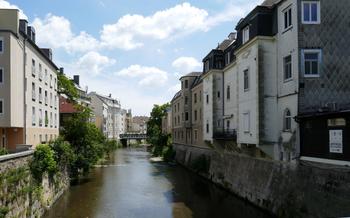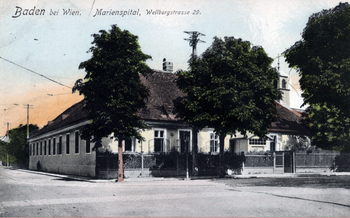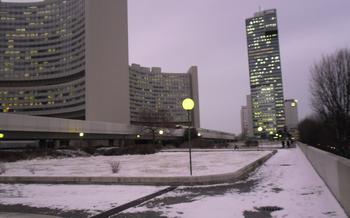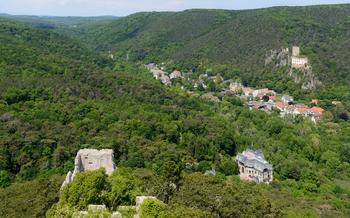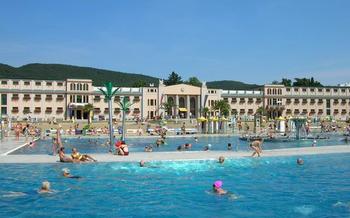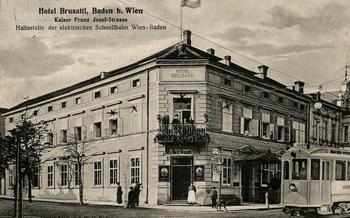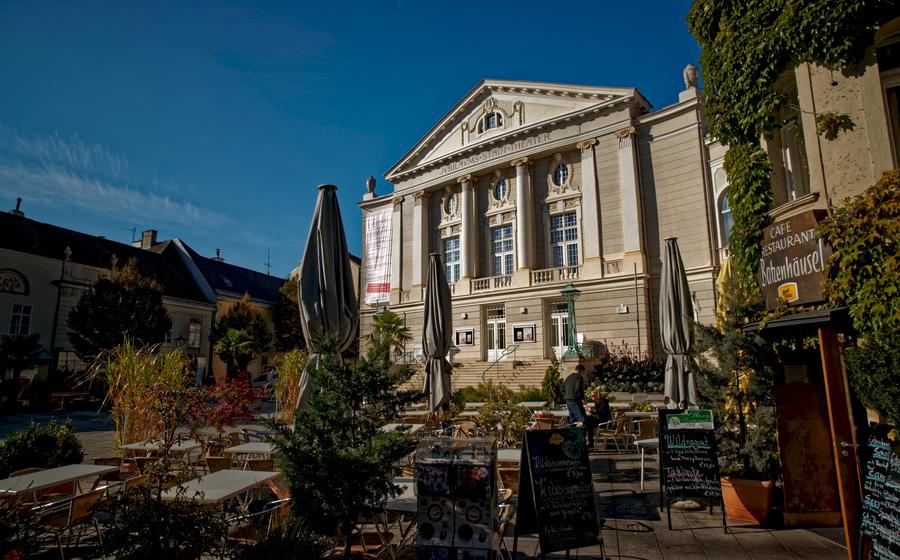
Biedermeierfriedhof
- Baden bei Wien: An Enchanting Town with a Rich History
- Biedermeierfriedhof: A Unique Cemetery with a Timeless Charm
- Exploring the Biedermeierfriedhof: A Journey Through Time
- Paying Respects to Wolfgang Amadeus Mozart's Son
- Unveiling the Stories of Famous Personalities
- Discovering the Symbolism and Art of Gravestones
- Walking Through History: A Self-Guided Tour
- Finding Peace and Serenity in a Tranquil Oasis
- Capturing the Essence of Baden's Heritage
- Respecting the Sacredness of the Cemetery
- Guided Tours and Local Insights
- Combining History with Local Delights
- Visiting the Cemetery During Special Events
- Accessibility and Practical Information
- Insider Tip: Discovering Hidden Gems
Baden bei Wien: An Enchanting Town with a Rich History
Baden bei Wien, a charming town nestled in the heart of Austria, boasts a rich and fascinating history that dates back to Roman times. Once a popular destination for the Roman elite, Baden bei Wien gained prominence during the Middle Ages as a center of wine production and trade. In the 18th century, the town underwent a transformation as it became a fashionable spa resort, attracting visitors from all over Europe for its therapeutic waters.
The town's reputation as a health resort continued to grow in the 19th century, and Baden bei Wien became a popular destination for the Viennese aristocracy and bourgeoisie. This period also saw the emergence of the Biedermeier style, a cultural movement characterized by its emphasis on simplicity, functionality, and domesticity. The town's architecture and atmosphere reflect this unique era, making it a living testament to the Biedermeier period.
Baden bei Wien is easily accessible by train or car from Vienna, making it a perfect day trip or weekend getaway. The town offers a variety of accommodation options, from cozy guesthouses to elegant hotels, ensuring a comfortable and memorable stay for visitors.
Whether you are a history buff, a culture enthusiast, or simply seeking a tranquil escape, Baden bei Wien has something to offer everyone. With its enchanting atmosphere, rich heritage, and abundance of things to see and do, this charming town is sure to leave a lasting impression.
Location and Accessibility:
Baden bei Wien is conveniently located just 25 kilometers south of Vienna, making it easily accessible by car or public transportation. The town is well-connected by train, with regular services departing from Vienna's main train station, Wien Hauptbahnhof. The journey takes approximately 25 minutes, and trains run frequently throughout the day.
Climate and Best Time to Visit:
Baden bei Wien enjoys a temperate climate with warm summers and mild winters. The best time to visit the town is during the spring (April-May) or autumn (September-October) when the weather is pleasant and the town is less crowded. However, Baden bei Wien is a year-round destination, and each season offers its unique charm.
Accommodation Options:
Baden bei Wien offers a wide range of accommodation options to suit every budget and preference. From cozy guesthouses and charming bed and breakfasts to elegant hotels and luxurious resorts, there is something for everyone. Many accommodations are located within walking distance of the town center and the Biedermeierfriedhof, making it easy to explore the town's attractions.
Biedermeierfriedhof: A Unique Cemetery with a Timeless Charm
The Biedermeierfriedhof, or Biedermeier Cemetery, is a captivating burial ground nestled in the heart of Baden bei Wien. Established in 1821, it is one of the oldest and most significant cemeteries in Austria. The Biedermeier Era, which spanned from 1815 to 1848, left an indelible mark on Austrian culture, and the Biedermeierfriedhof serves as a testament to this period of history.
Architectural Significance The cemetery showcases a rich array of architectural styles, reflecting the transition from Neoclassicism to Romanticism. From the classical lines of the main entrance to the Gothic Revival chapel, visitors are taken on a journey through architectural history. The graves themselves tell a story of the changing tastes and societal norms of the 19th century.
Notable Burials The Biedermeierfriedhof is the final resting place of many famous personalities who shaped Austrian history and culture. Among them is Franz Xaver Wolfgang Mozart, the son of the legendary composer Wolfgang Amadeus Mozart. Other notable burials include artists, writers, musicians, and politicians who contributed to Baden bei Wien's rich heritage.
Cultural Significance The Biedermeierfriedhof is not merely a burial ground but also a cultural treasure trove. It offers a glimpse into the social, political, and artistic milieu of the Biedermeier Era. Through its elaborate graves, monuments, and symbolism, the cemetery reflects the values, beliefs, and aspirations of a bygone era.
Exploring the Biedermeierfriedhof: A Journey Through Time
Strolling through the Biedermeierfriedhof is like embarking on a journey through time, where each gravestone tells a unique story. The cemetery's layout is designed in a grid pattern, with wide paths intersecting to create distinct sections. Each section represents a different period in the cemetery's history, with older graves located closer to the center and newer ones towards the periphery.
Among the famous graves and mausoleums that draw visitors' attention are those of renowned artists, writers, and musicians. The grave of Josef Lanner, one of the pioneers of Viennese waltz, is marked by a simple but elegant tombstone adorned with a lyre, a symbol of music. Nearby lies the grave of Franz Schubert, another musical genius, whose tombstone features a bust of the composer and a poignant epitaph that reads, "Music has buried here a rich treasure, but even fairer hopes."
Notable sculptures and monuments scattered throughout the cemetery add to its artistic significance. One of the most striking sculptures is the "Angel of Grief" by Hans Gasser, which depicts a weeping angel perched atop a broken column. The monument serves as a poignant reminder of the transience of life and the enduring power of grief.
Beyond the famous graves and monuments, the Biedermeierfriedhof is filled with hidden corners and symbolism that invite visitors to explore and interpret. The graves are adorned with a variety of symbols, including flowers, angels, and crosses, each carrying its own meaning. The weeping willows that line the paths of the cemetery symbolize mourning and loss, while the ivy that climbs the walls of the mausoleums represents eternal life. Every corner of the cemetery holds a story waiting to be discovered, inviting visitors to engage with the past and contemplate the mysteries of life and death.
Paying Respects to Wolfgang Amadeus Mozart's Son
The Biedermeierfriedhof holds a special significance for music enthusiasts as it is the final resting place of Franz Xaver Wolfgang Mozart, the son of the legendary composer Wolfgang Amadeus Mozart. Born in Vienna in 1791, Franz Xaver followed in his father's footsteps and became a renowned composer, conductor, and pianist. His compositions spanned various genres, including operas, symphonies, and chamber music.
Franz Xaver spent the latter part of his life in Baden bei Wien, where he found solace and inspiration in the town's tranquil surroundings. He passed away in 1844 at the age of 53 and was laid to rest in the Biedermeierfriedhof. His grave, marked by a simple yet elegant tombstone, is a poignant reminder of his musical legacy and the enduring influence of his father's genius.
For music lovers, visiting the grave of Franz Xaver Wolfgang Mozart is a pilgrimage of sorts. It is an opportunity to pay homage to a talented composer who carried on the Mozart name with distinction. The cemetery provides a serene and reflective setting to contemplate the lives and achievements of both father and son, whose music continues to captivate audiences worldwide.
In addition, the Biedermeierfriedhof hosts occasional memorial concerts and tributes dedicated to Franz Xaver Wolfgang Mozart. These events celebrate his contributions to the world of music and provide a platform for musicians to perform his compositions. Attending such events is a unique way to honor his memory and experience the enduring power of his musical heritage.
Unveiling the Stories of Famous Personalities
The Biedermeierfriedhof is not only the resting place of Wolfgang Amadeus Mozart's son, but also of many other renowned artists, writers, and musicians. Among them, two of the most prominent figures are Josef Lanner and Franz Schubert.
Josef Lanner, the "father of the Viennese waltz," is buried in a prominent location within the cemetery. His grave is adorned with a bust of the composer, surrounded by musical instruments and symbols of his craft. Visitors can pay their respects to Lanner and reflect on his significant contributions to Viennese music and culture.
Another notable figure interred at the Biedermeierfriedhof is Franz Schubert, one of the most beloved composers of the Romantic era. Although Schubert's grave is relatively modest compared to others in the cemetery, it is a poignant reminder of his tragic life and untimely death at the age of 3Visitors can pay homage to Schubert and contemplate the enduring legacy of his music, which continues to touch the hearts of millions worldwide.
In addition to these musical giants, the Biedermeierfriedhof is home to the graves of many other notable personalities, including artists, writers, and historical figures. Visitors can explore the cemetery grounds and discover the final resting places of individuals who have shaped Baden's cultural heritage and contributed to its rich history.
Discovering the Symbolism and Art of Gravestones
The Biedermeierfriedhof is a treasure trove of symbolism and artistic expressions. The intricate designs and epitaphs on the gravestones offer a glimpse into the beliefs, values, and cultural norms of the Biedermeier era. Flowers, angels, and crosses are recurring motifs, each holding a unique meaning. Roses symbolize love and remembrance, while lilies represent purity and innocence. Angels often serve as guardians or messengers, while crosses signify faith and hope.
The epitaphs, often written in elaborate calligraphy, provide poignant insights into the lives and legacies of the deceased. They express grief, love, and admiration, while also revealing the social and cultural context of the time. The gravestones themselves are works of art, showcasing the skills of stonemasons and sculptors. The intricate carvings and sculptures depict scenes from nature, religious iconography, and personal narratives, adding a layer of visual interest and depth to the cemetery.
Exploring the symbolism and art of the gravestones at the Biedermeierfriedhof is a journey into the past, allowing visitors to connect with the emotions, beliefs, and artistic expressions of a bygone era. It is a chance to reflect on the fragility of life, the power of memory, and the enduring legacy of human creativity.
Walking Through History: A Self-Guided Tour
Exploring the Biedermeierfriedhof at your own pace allows for a more personal and immersive experience. Begin your journey at the main entrance, taking a moment to admire the gate's intricate ironwork and symbolism. Stroll along the main paths, admiring the rows of headstones and monuments that line your way. Discover the different sections of the cemetery, each with its unique atmosphere and stories to tell.
Pay attention to the different styles of graves, from simple crosses to elaborate mausoleums. Read the epitaphs and inscriptions, which often provide insights into the lives and legacies of those buried here. Look for hidden corners and overlooked graves, where you may find forgotten stories or unique symbolism.
As you wander through the cemetery, imagine the lives of those who rest here. Consider their contributions to the arts, sciences, and culture of Baden bei Wien. Reflect on the history of the city and how it has shaped the lives of its people.
By taking the time to explore the Biedermeierfriedhof on your own, you'll gain a deeper appreciation for its beauty, history, and cultural significance. It's an opportunity to connect with the past and to discover the stories that lie beneath the surface of this tranquil oasis.
Finding Peace and Serenity in a Tranquil Oasis
Beyond its historical and cultural significance, the Biedermeierfriedhof offers a serene sanctuary for visitors seeking peace and tranquility. Amidst the hustle and bustle of modern life, the cemetery provides a tranquil oasis where one can escape the stresses of everyday existence. Visitors can wander through the serene paths, surrounded by the gentle rustling of leaves and the melodic chirping of birds. The tranquil atmosphere invites contemplation and reflection, allowing visitors to immerse themselves in the beauty of their surroundings and connect with their inner selves.
Whether seeking solace in the aftermath of a loss, searching for inspiration, or simply seeking a moment of tranquility, the Biedermeierfriedhof offers a refuge for those seeking peace and serenity. The harmonious blend of nature and history creates a unique ambiance that promotes relaxation and rejuvenation, allowing visitors to leave the cemetery feeling refreshed and revitalized.
Capturing the Essence of Baden's Heritage
The Biedermeierfriedhof is a treasure trove of photographic opportunities. The unique gravestones, intricate sculptures, and serene surroundings create a picturesque backdrop for capturing the essence of Baden's heritage. Photography enthusiasts can spend hours exploring the cemetery, documenting the diverse array of memorials and capturing the tranquil atmosphere.
Whether you're a professional photographer or simply enjoy taking snapshots, the Biedermeierfriedhof offers endless possibilities for capturing stunning images. The soft light filtering through the trees, the intricate details of the gravestones, and the peaceful ambiance create a unique and captivating setting for photography.
Preserving these memories through photographs not only allows you to share the beauty of the Biedermeierfriedhof with others but also contributes to documenting and preserving a significant part of Baden's cultural heritage. By capturing the essence of this historic cemetery, you become part of the ongoing effort to safeguard and celebrate the rich history of this special place.
Respecting the Sacredness of the Cemetery
The Biedermeierfriedhof is not just a historical site but also a sacred place of rest for the departed. As visitors, it is essential to maintain a quiet and reverent atmosphere while exploring the cemetery grounds. This includes refraining from loud conversations, laughter, or any other disruptive behavior that may disturb the peace and tranquility of the site.
Appropriate dress is also important when visiting the cemetery. While there is no strict dress code, it is generally recommended to dress respectfully, avoiding revealing or overly casual attire. This shows respect for the deceased and their families and helps maintain the solemnity of the environment.
It is also essential to be mindful of the privacy of grieving families who may be visiting the cemetery to pay their respects to loved ones. Refrain from taking photographs or recording videos of people without their consent, and avoid intruding on their private moments of remembrance.
Finally, it is crucial to preserve the historical significance of the cemetery by respecting the graves and monuments. Avoid touching or leaning on the tombstones and refrain from leaving any trash or personal belongings behind. By following these guidelines, visitors can help maintain the integrity and beauty of the Biedermeierfriedhof for future generations to appreciate.
Guided Tours and Local Insights
Enhancing your visit to the Biedermeierfriedhof with a guided tour offers a unique opportunity to delve deeper into the cemetery's rich history, symbolism, and cultural significance. Knowledgeable local guides, fluent in various languages, provide insightful commentary and unveil hidden stories and anecdotes that bring the cemetery to life. They can point out notable graves, explain the symbolism behind the gravestones, and share fascinating tales of the people buried here.
Guided tours are an excellent way to gain a more profound understanding of the cemetery's role in Baden's history and its significance as a cultural heritage site. By supporting local guides, you also contribute to preserving and promoting the cemetery's unique character and its importance to the community. Embrace the chance to connect with local experts and unlock the hidden treasures of the Biedermeierfriedhof.
Combining History with Local Delights
A visit to the Biedermeierfriedhof can be seamlessly combined with a culinary adventure in Baden bei Wien. The town is renowned for its delectable Viennese pastries, embodying the essence of Austrian coffee culture. Indulge in mouthwatering Sachertorte, Apfelstrudel, or Kaiserschmarrn at one of the charming cafés that line the streets.
Beyond pastries, Baden bei Wien offers an array of culinary delights. Explore local restaurants serving traditional Austrian cuisine, such as hearty Wiener Schnitzel, Tafelspitz, or Käsespätzle. Immerse yourself in the vibrant atmosphere of the town's markets, where you can find fresh produce, artisanal cheeses, and homemade delicacies.
Enjoy a leisurely lunch in the shade of trees at Kurpark, Baden's picturesque park. Sip on a refreshing glass of Austrian wine or beer as you admire the vibrant floral displays and the serene ambiance.
Indulging in Baden's culinary delights enhances the overall experience of visiting the Biedermeierfriedhof. It provides a delightful contrast to the historical and contemplative nature of the cemetery, creating a memorable and well-rounded visit.
Visiting the Cemetery During Special Events
The Biedermeierfriedhof comes alive during special events, offering visitors a unique perspective on this historic site. Commemorative ceremonies and memorial services are held throughout the year, honoring the lives of those buried within the cemetery walls. These events provide an opportunity to pay respects, learn about the history of the cemetery, and connect with the local community.
Seasonal events and exhibitions also add to the charm of the Biedermeierfriedhof. During the Christmas season, the cemetery is adorned with twinkling lights and festive decorations, creating a magical atmosphere. Special exhibitions showcase the history, art, and symbolism of the cemetery, providing visitors with a deeper understanding of its significance.
Visiting the Biedermeierfriedhof during a special event is an enriching experience that allows visitors to connect with the past, celebrate the lives of notable figures, and appreciate the unique beauty of this historic cemetery. Whether attending a commemorative ceremony, exploring a seasonal exhibition, or simply taking a leisurely stroll through the grounds, visitors will find that the Biedermeierfriedhof offers a truly special experience.
Accessibility and Practical Information
The Biedermeierfriedhof is open to the public daily, with varying hours depending on the season. Admission is free of charge, allowing visitors to explore the cemetery grounds at their leisure. For those with limited mobility, wheelchair accessible routes are available throughout the cemetery, ensuring that everyone can enjoy the tranquility and beauty of this historic site. Guided tours in various languages are offered regularly, providing visitors with deeper insights into the history, notable burials, and symbolism found within the cemetery. To plan your visit, check the official website or contact the local tourist information office for up-to-date information on tour schedules and booking procedures. Ample parking is available in the vicinity of the cemetery, making it easy for visitors to arrive by car. Public transportation options, such as buses and trams, also stop nearby, providing convenient access for those without a vehicle.
Insider Tip: Discovering Hidden Gems
Beyond the well-known graves and monuments, the Biedermeierfriedhof holds a treasure trove of hidden gems waiting to be discovered. Explore the cemetery's crypts and mausoleums, where elaborate interiors and fascinating stories lie concealed. Uncover lesser-known graves of notable figures who have shaped Baden's rich history. Pay attention to the unique symbolism and epitaphs etched into the gravestones, offering glimpses into the lives and beliefs of those who rest here.
As you wander through the cemetery, let your curiosity guide you. Find a quiet corner to sit and reflect, allowing the atmosphere of the place to transport you back in time. Engage with the locals, who may share stories and anecdotes that bring the cemetery's history to life. Creating a personal connection with the Biedermeier Era, you'll gain a deeper appreciation for the lives and legacies of those who have left their mark on this enchanting town.
